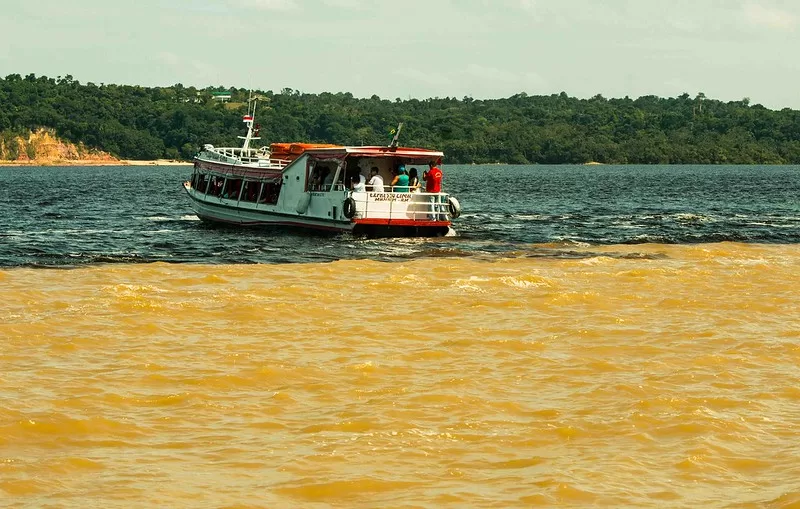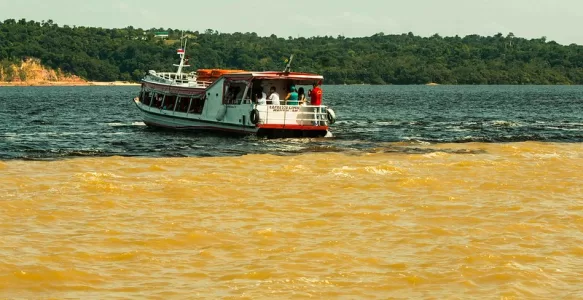The Amazon, one of the largest and most complex tropical rainforests on the planet, is characterized by an extensive network of rivers that form one of the world’s largest hydrographic basins. Among these waterways, the Negro and Solimões Rivers stand out, with their confluence being one of the most impressive and studied phenomena in the region. This merging of waters, which occurs in the city of Manaus, Amazonas state, is not only a visual spectacle but also a significant event of great scientific, ecological, and cultural importance.

Geography and River Extent
The Negro River extends approximately 1,000 km and is renowned for its dark coloration, resulting from decomposed organic matter that gives its waters an almost black hue. Its pH ranges between 5.1 and 0.6, indicating moderate acidity typical of rivers receiving large amounts of plant-derived organic material. The Negro River originates in Colombia, traverses Venezuela, and enters Brazil, forming a vast hydrographic basin that spans multiple Amazonian states.
Conversely, the Solimões River, considered the upper part of the Amazon River, stretches around 3,000 km, originating in the Andes Mountains on the border between Peru and Bolivia, flowing through Peruvian and Brazilian territory until its confluence with the Negro River. Its waters are lighter in color due to sediments and minerals from the Andean rocks, with a higher pH of approximately 6.9.
The Confluence: A Natural Spectacle
The confluence of the Negro and Solimões Rivers occurs in Manaus, Amazonas, and is a phenomenon of remarkable beauty and complexity. The waters of these rivers, with their distinct colors and characteristics, flow side by side for several kilometers before fully mixing. The visual separation is so striking that, from a distance, it appears as if two different-colored waters are running parallel, forming a natural boundary line.
This phenomenon results from differences in temperature, velocity, density, and chemical composition of the waters. The darker, warmer, and denser Negro River maintains its color over a long stretch, while the lighter, sediment-laden Solimões River retains its hue until natural mixing forces—such as currents and wind—integrate the waters.
Geology and Formation of the Confluence
The explanation for the differing colors and characteristics of the waters lies in the geology and origin of the rivers. The Negro River originates in igneous and metamorphic rocks in the Andes, where vegetal decomposition and dark organic matter impart its dark coloration. In contrast, the Solimões River originates from sedimentary rocks, contributing mineral sediments and sand particles that give its waters a lighter tone.
The confluence occurs in a geologically active region, where the underlying rocks influence the physical and chemical properties of the river sources. The interaction of these factors creates a visual spectacle that captivates residents, tourists, and scientists alike, and serves as an important case study in fluid dynamics and environmental processes.
Ecological and Biological Significance
The merging of the Negro and Solimões Rivers forms an ecosystem of extraordinary richness and diversity. Each river supports a wide array of fish species, aquatic plants, birds, and other animals adapted to their specific water conditions. The mixing of these waters creates a unique environment where different biological communities coexist and interact.
The Negro River, with its acidity and low sediment load, hosts fish species adapted to more acidic and low-turbidity waters, while the Solimões, with its sediment-rich waters, sustains fauna adapted to high turbidity and abundant nutrients. Over time, this mixing fosters a highly productive environment, fundamental to the region’s food chain.
Furthermore, the confluence area serves as a breeding and feeding ground for numerous migratory species that utilize these rivers as migration routes and spawning sites. The region’s biodiversity is among the highest globally, including iconic species such as the pirarucu fish, the pink river dolphin, the jaguar, and countless aquatic birds.
Environmental Impacts and Challenges
Despite its natural beauty and ecological importance, the confluence region faces numerous environmental challenges. Increasing human activity—such as deforestation, mining, overfishing, and urban expansion—threatens the integrity of aquatic and terrestrial ecosystems. Pollution, pesticide use, and industrial waste discharge further compromise water quality and species health.
Global warming and climate change pose additional threats, altering rainfall patterns, flood and drought regimes, and impacting river dynamics and species distribution. Sea level rise, for example, could affect floodplain areas and habitats of aquatic and terrestrial species.
Preserving the confluence of the Negro and Solimões Rivers requires coordinated efforts among governments, local communities, environmental organizations, and civil society. Implementing protective policies, combating illegal deforestation, regulating fishing activities, and promoting sustainable tourism are essential steps to safeguard this natural heritage.
Cultural and Historical Significance
The confluence also holds profound cultural meaning for indigenous peoples, riverine communities, and traditional populations of the Amazon. For these groups, the rivers symbolize life, spirituality, and cultural identity. Many communities see the merging of the rivers as a symbol of unity, strength, and continuity.
Historically, the region has been a site of expeditions, discoveries, and cultural exchanges that have shaped the history of Amazonas. Manaus, which developed around this confluence, has become a hub of commerce, culture, and research, attracting scholars and tourists interested in the beauty and complexity of the Amazon ecosystem.
The confluence of the Negro and Solimões Rivers is undoubtedly one of nature’s most impressive phenomena, representing a synthesis of the geological, ecological, and cultural diversity of the Amazon. Its scenic beauty, coupled with its importance for biodiversity and local communities, makes this event a symbol of the richness and complexity of the world’s largest tropical biome.
Preserving this natural heritage is a collective responsibility, as it is not merely a tourist attraction or scientific curiosity but a vital element for the planet’s environmental balance. Awareness, environmental education, and the implementation of sustainable policies are crucial to ensure that future generations can continue to admire and learn from this natural spectacle.


